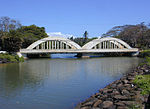Kaukonahua River
Bodies of water of OahuHawaii geography stubsRivers of HawaiiWestern United States river stubs
The Kaukonahua Stream or Kaukonahua River is a 9.9-mile-long (15.9 km) river on the island of Oʻahu which is one of the Hawaiian Islands. Including its longer South Fork, the stream's total length is 28.0 miles (45.1 km). It flows down in a generally northwest direction, from 21°30′7″N 157°54′13″W into the Pacific Ocean. The North and South forks meet at coordinates 21°29′44″N 158°5′50″W. It is the longest river of the whole island group. It empties into Kaiʻaka Bay near Waialua, Hawaii.
Excerpt from the Wikipedia article Kaukonahua River (License: CC BY-SA 3.0, Authors).Kaukonahua River
Cane Haul Road,
Geographical coordinates (GPS) Address Nearby Places Show on map
Geographical coordinates (GPS)
| Latitude | Longitude |
|---|---|
| N 21.579722222222 ° | E -158.11944444444 ° |
Address
Cane Haul Road
Cane Haul Road
96791
Hawaii, United States
Open on Google Maps







